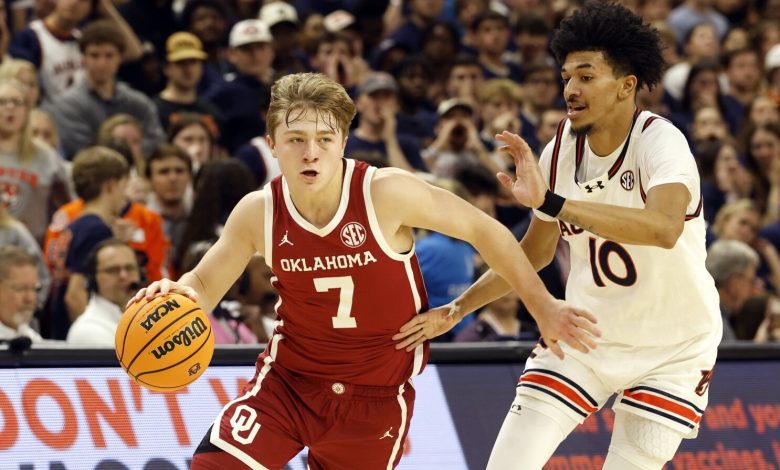With 15 points apiece from Broome and Baker-Mazara, No. 1 Auburn defeats Oklahoma 98-70.

In a matchup that showcased the high-flying, offensive prowess of the Auburn Tigers, Bruce Pearl’s team delivered an emphatic 98-70 victory over the Oklahoma Sooners. The No. 1-ranked Auburn Tigers demonstrated their championship credentials by dominating every phase of the game, from offensive execution to defensive intensity. With standout performances from Johni Broome and Allen Baker-Mazara, each contributing 15 points, Auburn put on a show that reminded everyone why they’re one of the most dangerous teams in college basketball.
The victory further solidified Auburn’s place atop the rankings, reaffirming their standing as a true contender for a national championship. The game was filled with scoring runs, incredible athleticism, and seamless teamwork, all hallmarks of a team capable of making a deep run in the NCAA Tournament.
In this article, we’ll break down the key elements of Auburn’s victory over Oklahoma, including the performances of Broome and Baker-Mazara, the effectiveness of Auburn’s offensive and defensive schemes, and how this win bolstered their credentials as a top contender. Moreover, we will examine how the Tigers’ playstyle and coaching philosophy mesh together to create a team with championship potential.
1. Offensive Explosion: Balanced Scoring Attack
The 98-70 victory over Oklahoma was, in many ways, a masterclass in offensive efficiency. Auburn’s ability to generate points from various avenues—be it through fast breaks, three-pointers, or offensive rebounds—was evident from the start. This type of offensive output has become a trademark of Bruce Pearl’s system, which thrives on quick ball movement, spacing, and versatility. Against Oklahoma, Auburn shot an impressive percentage from the field, shooting just under 50% overall and converting on key three-pointers when needed. The Tigers displayed remarkable balance, with multiple players stepping up to score, showing that they are not dependent on any single player to lead the offense.
Leading the charge for Auburn were Johni Broome and Allen Baker-Mazara, who each scored 15 points. Broome, the versatile forward and key player for Auburn, demonstrated his ability to score inside and stretch the floor, hitting key jump shots and contributing with his basketball IQ. Broome’s performance was a clear example of the type of multi-faceted player that Auburn relies on to fuel their offense. His ability to drive to the basket, finish through contact, and knock down perimeter shots makes him one of the most complete players in the country.
Baker-Mazara, a player known for his scoring ability and athleticism, also played a pivotal role in the offensive onslaught. His smooth shooting stroke, combined with his ability to drive and attack the rim, gave Auburn the kind of dynamic offensive presence needed to overpower Oklahoma’s defense. Baker-Mazara’s 15 points came on a combination of efficient shooting, cutting to the basket, and benefiting from fast-break opportunities—each facet of his game contributing to Auburn’s overall scoring depth.
But the contributions didn’t stop with Broome and Baker-Mazara. The Tigers have long been known for their offensive depth, and this game was no different. Auburn’s high-scoring output was driven by several players who made significant contributions in various facets of the game. Wendell Green Jr. and Allen Flanigan provided scoring from the perimeter and mid-range, while Chris Moore added a spark off the bench with his energy and transition play. Auburn’s unselfish ball movement helped them create open shots for everyone on the floor, which kept Oklahoma’s defense on its heels. The result was a high-scoring affair, with Auburn putting up 98 points, a reflection of the Tigers’ offensive depth.
Auburn’s offensive system is designed for a fluid, fast-paced style of play. The Tigers are comfortable in transition, looking to push the ball up the floor and get easy buckets before opposing defenses can set up. Against Oklahoma, this speed was evident as Auburn dominated the fast break. The Tigers were quick to capitalize on turnovers and missed shots, regularly turning them into fast-break opportunities. This emphasis on speed allowed Auburn to consistently generate high-percentage shots and avoid allowing Oklahoma to settle into their defense. The result was a performance where Auburn’s offense overwhelmed the Sooners at every turn.
In a season where scoring is often dominated by individual performances, Auburn’s ability to share the ball and create open shots for everyone on the floor is a testament to Bruce Pearl’s coaching philosophy. Auburn’s offensive efficiency is rooted in the team’s chemistry, and the Tigers’ ability to move the ball, read defenses, and play with pace positions them as a serious national contender.
2. Defense: Stifling and Relentless
While Auburn’s offense was certainly a key component of the victory, their defense was equally impressive. A championship team needs to be able to win games on both ends of the floor, and against Oklahoma, the Tigers showcased their defensive depth and tenacity. Auburn’s defense was aggressive, fast, and disciplined, all qualities that will serve them well as they aim for a national title.
Auburn’s full-court pressure, combined with intense half-court defense, limited Oklahoma’s offensive flow. The Sooners struggled to get into a rhythm and were often forced into contested shots or turnovers. Auburn’s defenders, led by Broome and Green Jr., were relentless in their pursuit of the ball, constantly pressuring Oklahoma’s guards and limiting their opportunities. The Tigers were particularly effective at contesting shots, forcing Oklahoma to take tough, low-percentage attempts.
Broome was exceptional defensively, using his length and athleticism to disrupt passing lanes and challenge shots. His awareness on the defensive end allowed Auburn to generate turnovers, which led to fast breaks and easy buckets on the other end. The versatility of Broome—able to switch between guarding multiple positions and being a constant presence in the paint—allowed Auburn to remain flexible in their defensive schemes. Whether it was switching between man-to-man or a matchup zone, Auburn’s defense adapted to keep Oklahoma off balance.
Green Jr., who is known for his on-ball defense, was also crucial in keeping the Sooners from finding open looks. His ability to disrupt Oklahoma’s offensive flow and force them into hurried shots was key in preventing the Sooners from mounting any sort of offensive comeback. The constant defensive pressure from Auburn helped to slow Oklahoma’s fast break and denied them easy opportunities.
Additionally, Auburn’s ability to defend without fouling was critical. They were able to challenge shots and make plays without putting Oklahoma on the free-throw line too often. This allowed the Tigers to stay in control of the tempo and avoid letting Oklahoma gain any momentum from foul shots.
Another area of strength for Auburn was their rebounding. The Tigers were aggressive on the boards, limiting Oklahoma to one shot per possession and grabbing critical rebounds, particularly on the offensive glass. Auburn’s effort on the glass allowed them to extend possessions, while also preventing Oklahoma from getting second-chance points.
Auburn’s defense in this game displayed their championship potential. To win a national title, teams need to be able to lock down opponents in critical moments, and Auburn’s defense against Oklahoma demonstrated that they are more than capable of doing so.
3. The Role of Coaching: Bruce Pearl’s Masterful Strategy
Bruce Pearl has long been recognized as one of the top basketball minds in college basketball, and his leadership has played a pivotal role in Auburn’s rise to the top of the rankings. Pearl’s coaching philosophy is centered around playing fast, applying constant pressure on defense, and ensuring that every player is involved in the offense. Against Oklahoma, Auburn’s game plan was executed flawlessly, with the Tigers playing with intensity on both ends of the floor.
Pearl’s emphasis on team-oriented basketball is what makes Auburn so dangerous. His ability to get the best out of each player is evident in the way the Tigers share the ball, contribute defensively, and buy into the team concept. Auburn’s offensive flow, with a focus on spacing and ball movement, is a direct reflection of Pearl’s coaching principles. Additionally, his ability to make in-game adjustments was apparent in the way Auburn responded to any run by Oklahoma. Whether it was altering defensive schemes or adjusting the tempo, Pearl ensured that Auburn stayed in control of the game from start to finish.
What stands out most in Pearl’s coaching style is his ability to get his players to buy into his system. Auburn’s players play with energy, focus, and a clear sense of purpose, which speaks to Pearl’s leadership. In a game where the margin for error is often razor-thin, Auburn’s discipline and execution were the difference-makers.









